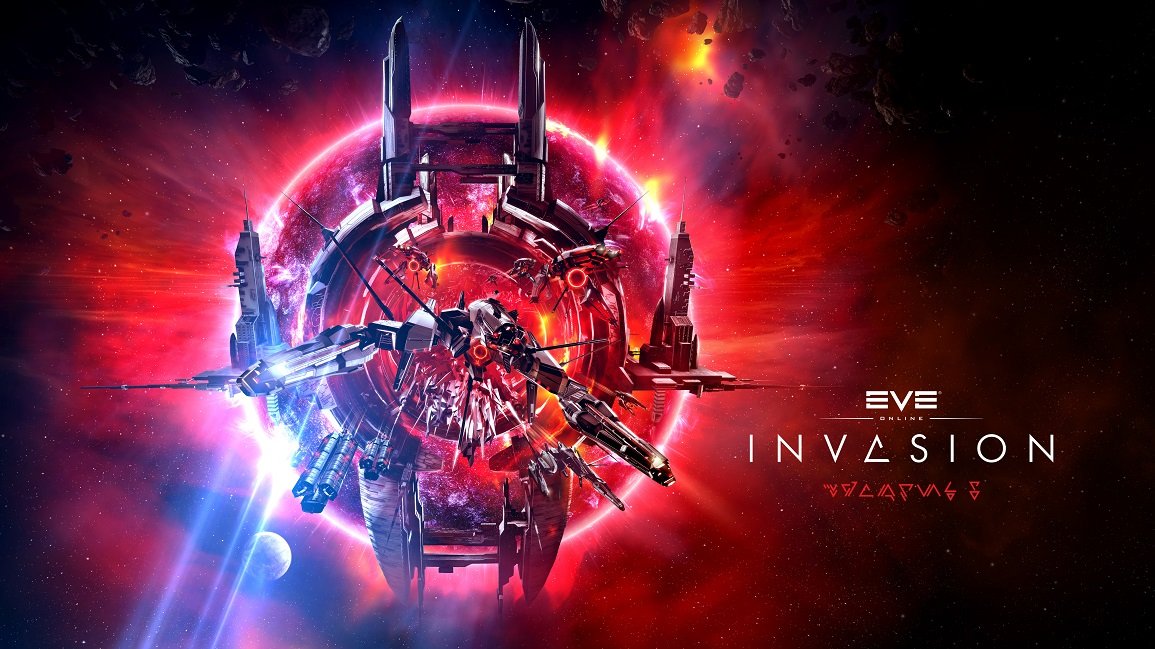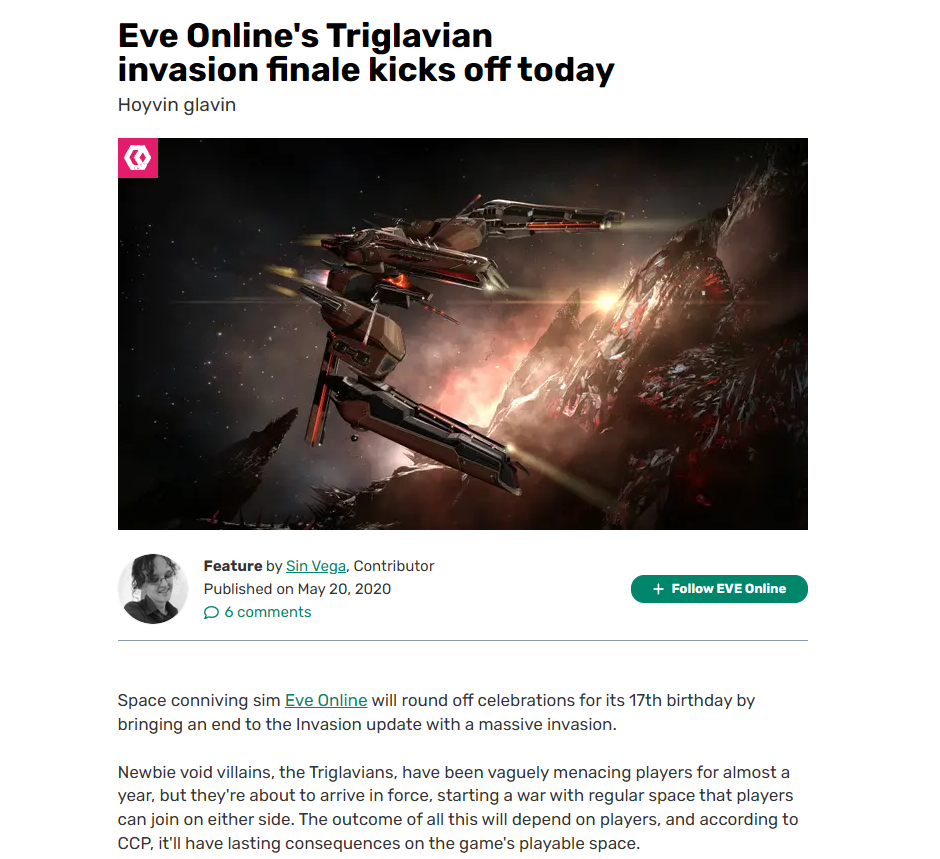
The Triglavians — a shadowy alien race living in the dangerously unpredictable Abyssal Deadspace pockets — have begun an invasion into the New Eden star cluster. Players are called to action to defend the empires of New Eden, and drive back the emergent threat.

In May 2019, my team released the first piece of what would eventually become a nearly two year, multi-expansion narrative arc. Invasion permanently changed the landscape of New Eden, (EVE Online’s star cluster), and greatly expanded the game’s mechanics, content delivery systems, and authoring tools. It also contributed to the highest monthly active user count EVE had seen in approximately half a decade.
When we were informed that Invasion was likely to be a multi-part release arc, so my co-designer and I set about the project as a series of releases that would build off of each other. Many of the features that we wanted to implement were large enough shifts to established paradigms that we decided the best approach would be to first introduce each of them in small, bite-sized pieces. This enabled us to ensure player experience and interactions reflected desired goals, and also gave our engineers the capacity to reinforce and polish underlying structural work before we applied a feature more liberally.
*The team consisted of my co-designer and I, two engineers, two QA, and a producer. For transparency’s sake, any part of the art that I was not a primary contributor on is not featured in this portfolio. Though all work was performed as a collaboration with my co-designer and the lines often became blurry, I primarily owned these features as initial designer, implementer, or both. I have attempted to clarify our individual contributions and focus solely on my work.
Table of Contents
Pochven (Evergreen Content)
Please excuse the dust as this portfolio piece is still being put together.

Design Goals
Leadership’s instruction was for my team to tell the story of an invading force. While their initial vision was of a traditional dynamic of consumed narrative content, Gregor (my co-designer) and I instead proposed that players take part in a battle for their universe and meaningfully impact how it unfolded. EVE Online’s entire brand is built upon player agency, and we felt it was important that we expand that beyond the interactions between players to include their relationship with PvE and Seasonal content. Leadership immediately agreed.
There were three pillars that Gregor and I identified to this end.
Content provides meaningful choice
The choices a player makes surrounding content meaningfully impacts the way in which it progresses, as well as how that content affects the world and gameplay systems around it.
Content fuels multiplayer interaction
It incentivizes players to collaborate, provides sources of conflict, and offers a variety of tools to wield against each other.
Content is alive
It doesn’t wait for players. It escapes, interrupts, chases, and progresses even without player intervention. After all - invaders don’t wait to be engaged.

Chapter 1: Invasion
Released: May 2019
The Triglavian Collective have begun to exert influence on systems within the high-security regions of New Eden. Escalating system-wide effects have been observed and Triglavian forces are roaming these systems in varied fleet sizes and compositions. Rumors spreading from capsuleer expeditions into Abyssal Deadspace indicate that these first waves of Triglavian vessels may be the vanguard of a larger invasion force yet to reveal itself.
Chapter 1 used existing tools to craft a series of semi-scripted roaming beachheads where invaders disrupted player activity and spilled out into neighboring star systems until dispersed. As the Triglavian influence grew, the systems took on Abyssal aesthetics and nearby players received positive and negative status effects designed to temporarily shift the balance of player options.
Virtually all of the content in EVE Online is restricted to "dungeons" - dynamically spawned locations in space, typically containing set dressing, NPCs, and interactive objects such as asteroids or destructible structures. This means that players can completely ignore content they do not wish to interact with - a dynamic that does not feel terribly appropriate to an invasion scenario. As such, we adapted existing roaming AI behaviors to build "escaping" content, where specified NPCs will leave the dungeon where they spawn in order to roam the solar system and engage players wherever they might be. This managed to make the invaded systems dangerous to the careless player, disrupting player shipping lanes and creating dynamic gameplay where the players and NPCs engaged in cat-and-mouse hunting scenarios.
We also designed and built three more traditional dungeons, each a carefully hand-crafted combat experience and culminating in the epic World Ark fight that signaled an invasion's peak. In these we experimented with more complex dungeon logic, implementing mechanics designed to encourage creative gameplay and create meaningfully dynamic terrain.
Throughout the summer months, we made balance adjustments and expanded the content with an additional escaping fleet and dungeon. These entry-level variants of standard Invasion content were distributed separate from the beachheads, serving as on-ramps for new players and hesitant veterans. They were incredibly popular, becoming the most-completed content in the game within six months of their release.
Feature Owners:
Dylan (Capstone dungeons, Beach Head structure)
Gregor (NPC AI, basic dungeons).
Favorite Features
Roaming Beach Heads
Escaping Content
World Ark Dungeon

Chapter 2: Rapid Fire
Released: Incrementally, Fall 2019
CONCORD has established observatories to study Triglavian Stellar Accelerators. Capsuleers are asked to assist local Empire forces in defending these vital intelligence structures from assault by the Collective.
Following the success of Chapter 1, we were tasked with crafting the content for its follow-up Fall release. For this, we focused on expanding player agency in the narrative and experimented with persistent changes to the world.
Leading up to the official November release, we distributed a new dungeon which, at its conclusion, had the potential to leave behind a persistent, NPC-built structure. This “Stellar Accelerator” could be destroyed by players at any time, but emitted mechanical balance shifts to the entire solar system while it lived. In this way, players could collectively choose to alter or maintain the rules of their shared play area.
For the full release, we expanded the existing Triglavian ship line, providing players who wished to fly the race's unique ships an exciting new option. This "Zirnitra" ship was specifically designed to counter and destroy large, capital-sized vessels and player-built structures, dealing more damage the longer it focused on a target and working the racial mechanics into an enjoyable niche of the gameplay economy.
We also developed a dungeon to showcase the Zirnitra. In this content experience, players were given a choice to progress down multiple paths, choosing to either fight the Triglavian invaders or turn on the empires that sought the players' aid. In either case, Zirnitra-class ships (and their empire counterparts) would appear on the field, fighting either against or alongside the players, showcasing the power they could bring to bear.
Just as we did for Chapter 1, my team supported the expansion post-release with content updates, balance changes, and even traveled to player gatherings to engage our users, promote the content, and receive feedback.
Feature Owners:
Dylan (Persistent Structures, Dynamic Deployment AI, Zirnitra)
Gregor (Capstone “Choose Your Side” dungeon & AI upgrades).
Favorite Features
Persistent Structures
New Player Options
Pick-Your-Side Content

Chapter 3: Eclipse
Released: May 2020
As seismic events occur and continue to unfold over the coming weeks and months, capsuleers will have important decisions to make. Will they choose between defending the Empires of New Eden or siding with the mysterious Triglavian Collective? These choices will have a direct impact on how the Invasion story develops, and will have lasting consequences in New Eden, ensuring that life in the cluster will never be the same again.
For the third and final chapter of the Triglavian storyline, my team completely reworked the Invasion feature set, building off of early experiments and implementing systems that our engineers had been secretly preparing for use.
At its heart was a capacity for players to ally themselves with either the Triglavian Collective or the newly formed United New Eden Common Defense Initiative (EDENCOM). Dungeon and escaping content was developed for both sides, and NPCs dynamically tracked allies and enemies among both the players and fellow NPCs, aiding and even actively healing those who regularly allied themselves with their respective faction. This meant that, when flying through an invaded system, players were likely to find themselves in the center of massive brawls where NPCs and players alike fought in mixed fleets. This was all made possible by the incremental testing of AI developments throughout the year prior, and careful analysis of their impact on server load.
In order to maximize the importance of choosing sides, we overhauled the content distribution system. Instead of beachheads that deployed content to progressively distant solar systems as the invasion instance linearly progressed, we instead implemented a branching tree of distribution scenes built upon a tug-of-war mechanic. As content for one side was completed, that faction's influence over the system increased. At specified steps, this altered the distribution of content in that solar system, causing conflict to escalate and peak before finally settling into a permanent state of victory for one side or the other.
As the solar system was pulled back and forth between the two factions, NPCs from the controlling group would dynamically deploy persistent structures. This built upon work proved out by Chapter 2's Stellar Accelerator, and included an array of accelerator-styled buff/debuff objects, as well as faction-focused defense platforms on star gates, and even structures that would slowly strip-mine local asteroid belts if left alone. These drastically reshaped the systems they were deployed in, and in many cases became beloved members of the local community. Most importantly, the destructible nature of these persistent objects gave players the capacity to choose how their neighbourhood was reshaped by the event.
The single most impactful element of Invasion: Chapter 3, however, was that any Triglavian-leaning location had its system security lowered. As the invaders progressed toward victory, the local space police found it difficult to enforce the law, and zones that were previously safe now allowed player-versus-player gameplay. This was groundbreaking for EVE, as the security level of a system had never changed in the game's 17 year history, and certainly not in any player-controllable way. Raravoss--a previously quiet and peaceful system, and the first to fall to Triglavian rule--became for over a week the most active combat site in the game, with tens of thousands of player ships being destroyed in just a few days. This week is now known by players as the Raravoss Bloodbath.
Feature Owners:
Joint (Tug-of-War system & Dynamic Security Status)
Dylan (Dynamic Persistent Structures & Related AI, Updated Capstone Dungeons)
Gregor (Expanded Pick-Your-Side AI)
Favorite Features
New Tug-of-war BeachHead
Pick-Your-Side Escaping AI
Dynamic Rules of Engagement
New Persistent Structures
Media and Press
Game designs can really only be fully understood through play. No matter how detailed and complete (or concise and specific) a document is, it really isn’t the same thing. Believe me — I get it. As I can’t wind back the clock and let you play through the event arc, here is a compilation of press articles and player reports about The Invasion, some of which have been linked to elsewhere in this portfolio.














